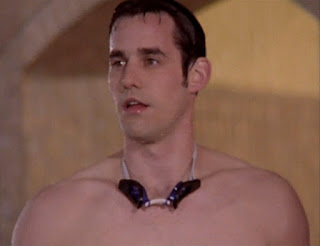Copyright 2011 by Gary L. Pullman
Haunted houses are easy. Well, the signs that a house may be haunted are easy to spot, anyway. Things seem to move of their own accord. Last night, your car keys were on the dresser; this morning, they’re on the kitchen counter, beside last night’s leftover Chinese takeout meal. You hear strange noises. Slime oozes down the walls. There’s a foul stench--and it’s not coming from the leftover Chinese food. Ghosts are seen--or something that could be ghosts.
The signs of the presence of a monster are not so easy to spot. But there are some, for those who have the eyes to see them. In his short story, “The Damned Thing,” there are signs aplenty of a monster’s presence. Invisible, its presence is known by its effects upon vegetation and, indeed, human beings. During a fishing and hunting expedition with his friend Hugh Morgan, Harker, who witnessed Morgan’s death, says the two men heard “a noise as of some animal thrashing about in the bushes, which we could see were violently agitated.” Morgan aims his shotgun in the direction of the noise, and when Harker asks what has made the commotion, Morgan replies, “That Damned Thing.” Harker then sees a peculiar sight, which he describes, to the coroner’s jury investigating Morgan’s death, in the following manner:
"I was about to speak further, when I observed the wild oats near the place of the disturbance moving in the most inexplicable way. I can hardly describe it. It seemed as if stirred by a streak of wind, which not only bent it, but pressed it down--crushed it so that it did not rise; and this movement was slowly prolonging itself directly toward us.A few moments later, Morgan is attacked, and, as he looks on in horror, Harker hears
“. . . Morgan crying out as if in mortal agony, and mingling with his cries were such hoarse, savage sounds as one hears from fighting dogs. Inexpressibly terrified, I struggled to my feet and looked in the direction of Morgan's retreat; and may Heaven in mercy spare me from another sight like that! At a distance of less than thirty yards was my friend, down upon one knee, his head thrown back at a frightful angle, hatless, his long hair in disorder and his whole body in violent movement from side to side, backward and forward. His right arm was lifted and seemed to lack the hand--at least, I could see none. The other arm was invisible. At times, as my memory now reports this extraordinary scene, I could discern but a part of his body; it was as if he had been partly blotted out--I cannot otherwise express it--then a shifting of his position would bring it all into view again.
"All this must have occurred within a few seconds, yet in that time Morgan assumed all the postures of a determined wrestler vanquished by superior weight and strength. I saw nothing but him, and him not always distinctly. . . . “One way to recognize the presence of a monster, then, is by its effects upon its environment. Other stories in which invisible or nearly invisible monsters may be recognized by such signs include the short stories “The Horla” by de Maupassant and “What Was It?” by Fitz-James O’Brien and the motion picture Predator, directed by John McTiernan.
Monsters are sometimes recognizable by their unique signatures, or distinctive marks. For example, vampires are often suspected when it is discovered that the throats of human corpses bear puncture wounds such as those that a large snake--or a bloodsucking fiend--leave as a result of slaking their thirst. There are a number of other ways by which to recognize vampires, according to The Vampire Hunter’s Guide, including:
It’s hard to miss a demon: the claws, horns, tail, and cloven hooves are sure giveaways. However, a demon that takes up residence inside a person, possessing him or her, may be more difficult to detect, especially when he or she can be confused with the effects of organic or mental illnesses. In fact, until quite recently, the mentally ill were often considered to be people possessed by demons. A movie, The Exorcism of Emily Rose, makes it clear how difficult it can be, even for a priest who has been trained as an exorcist, to make the distinction between madness and demonic possession. This film also makes it clear how tricky the terrain becomes, legally speaking, when one seeks to exorcize demons that may or may not actually exist and the mad (or possessed) person dies in the course of the exorcism. It’s best to leave exorcisms to the exorcists or psychiatrists, but, for those who are too willful or stubborn (or stupid) to do so, these may be signs, according to the website Demonbuster, of the presence of an indwelling demon:
- Fangs
- Red eyes
- Long nails
- Paleness
- Reluctance to enter house without invitation
- Hairy palms
- Aversion to bright lights
- No appetite
- Never seen during the day hours (not always true with some species)
- Possesses remarkable strength
- Has quiet footsteps
- Possesses knowledge about botany, with a large collection of soil in a house or in a vicinity
- Resides in an abode deemed evil by others
- Strange clothing habits
- Evidences enormous sexual appeal
- People who know him/ her frequently die
- Rarely, if ever, discusses religion
- Really bad breath
- Disturbances in the emotions which persist or recur.
- Disturbances in the mind or thought life.
- Outbursts or uncontrolled use of the tongue.
- Rcurring unclean thoughts and acts regarding sex.
- Addictions to nicotine, alcohol, drugs, medicines, caffeine, food, etc.
- Many diseases and physical afflictions are due to spirits of infirmity (Luke 13:11).


























